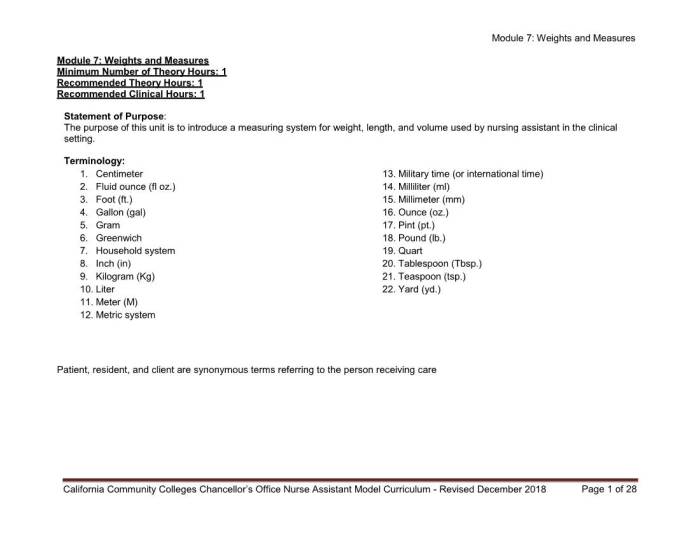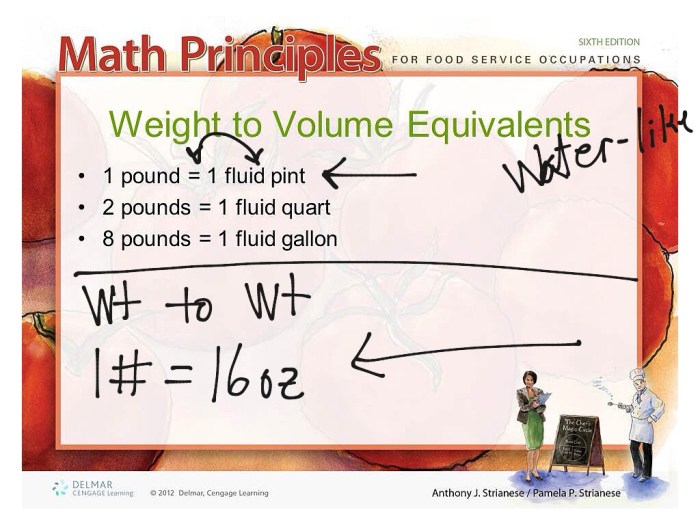Module 7 weights and measures – Module 7: Weights and Measures delves into the fascinating world of measurement, exploring its significance in various industries and the evolution of measurement systems throughout history.
From understanding the fundamental units of measurement to mastering conversion factors, this module equips you with the knowledge and skills to navigate the intricate world of weights and measures with confidence.
Module 7: Weights and Measures

Accurate weights and measures are critical in various industries, including trade, commerce, engineering, manufacturing, and medicine. They ensure fairness in transactions, enable precise calculations, and maintain safety standards. The history and evolution of weights and measurement systems have shaped our understanding of the world and facilitated advancements in science, technology, and everyday life.
History and Evolution of Weights and Measurement Systems
The earliest known weights and measures date back to ancient civilizations, with different cultures developing their own systems based on natural references like body parts, grains, and celestial bodies. Over time, standardized systems emerged, such as the metric system, which is now widely accepted as the international standard.
Units of Measurement

Units of measurement are essential for quantifying and comparing physical quantities. They provide a standardized way to describe the size, weight, volume, and duration of objects and events. Here’s a comprehensive table listing the most common units of measurement for length, mass, volume, and time:
Length
- Meter (m): The base unit of length in the International System of Units (SI). It is defined as the distance traveled by light in a vacuum in 1/299,792,458 of a second.
- Kilometer (km): 1,000 meters. Used to measure long distances, such as the distance between cities or the circumference of the Earth.
- Centimeter (cm): 0.01 meters. Used to measure smaller lengths, such as the height of a person or the width of a book.
- Millimeter (mm): 0.001 meters. Used to measure very small lengths, such as the thickness of a sheet of paper or the diameter of a wire.
- Inch (in): A unit of length commonly used in the United States and some other countries. 1 inch is equal to 2.54 centimeters.
- Foot (ft): A unit of length commonly used in the United States and some other countries. 1 foot is equal to 12 inches or 0.3048 meters.
Mass
- Kilogram (kg): The base unit of mass in the SI. It is defined as the mass of the International Prototype Kilogram, a cylinder made of platinum-iridium alloy.
- Gram (g): 0.001 kilograms. Used to measure smaller masses, such as the mass of a piece of fruit or a bag of sugar.
- Milligram (mg): 0.000001 kilograms. Used to measure very small masses, such as the mass of a grain of sand or a dust particle.
- Pound (lb): A unit of mass commonly used in the United States and some other countries. 1 pound is equal to 0.453592 kilograms.
- Ounce (oz): A unit of mass commonly used in the United States and some other countries. 1 ounce is equal to 28.3495 grams.
Volume
- Liter (L): The base unit of volume in the SI. It is defined as the volume of a cube with sides of 10 centimeters.
- Milliliter (mL): 0.001 liters. Used to measure smaller volumes, such as the volume of a medicine dose or a cup of coffee.
- Cubic meter (m³): The volume of a cube with sides of 1 meter.
- Gallon (gal): A unit of volume commonly used in the United States and some other countries. 1 gallon is equal to 3.78541 liters.
- Pint (pt): A unit of volume commonly used in the United States and some other countries. 1 pint is equal to 0.473176 liters.
Time
- Second (s): The base unit of time in the SI. It is defined as the duration of 9,192,631,770 periods of the radiation corresponding to the transition between two energy levels of the cesium-133 atom.
- Minute (min): 60 seconds. Used to measure shorter durations, such as the time it takes to brush your teeth or cook a meal.
- Hour (h): 60 minutes. Used to measure longer durations, such as the length of a workday or a movie.
- Day: The time it takes for the Earth to complete one rotation on its axis. It is approximately equal to 24 hours.
- Year: The time it takes for the Earth to complete one orbit around the Sun. It is approximately equal to 365.25 days.
Units of measurement are used in various fields, including science, engineering, medicine, and everyday life. They allow us to quantify and compare physical quantities, ensuring accuracy and consistency in measurements.
Conversion Factors

Conversion factors are mathematical values used to convert measurements from one unit to another within the same or different measurement systems. Understanding conversion factors is crucial for accurate measurement and data analysis in various fields.
To convert between different units within the same system, we simply multiply or divide the original measurement by the appropriate conversion factor. For example, to convert 12 inches to feet, we divide by 12 since there are 12 inches in a foot.
Module 7 weights and measures are crucial for understanding the world around us. Whether you’re measuring ingredients for a recipe or calculating the cost of a sandwich from cousins subs menu with prices , understanding weights and measures is essential.
Module 7 provides a comprehensive overview of this topic, ensuring you’re well-equipped to navigate the world of measurement.
Similarly, to convert 500 grams to kilograms, we divide by 1000 since there are 1000 grams in a kilogram.
Converting Between Measurement Systems
Converting between different measurement systems requires a more complex approach. The metric system, widely used in science and many countries, is based on powers of 10. The imperial system, commonly used in the United States, is based on a combination of different units, including inches, feet, pounds, and gallons.
To convert between metric and imperial units, we use specific conversion factors. For example, to convert 2.54 centimeters to inches, we multiply by 0.3937 since there are 2.54 centimeters in an inch. To convert 1 gallon to liters, we multiply by 3.785 since there are 3.785 liters in a gallon.
It’s important to note that conversion factors are not exact and may vary depending on the specific context and application. However, they provide a standardized and convenient way to convert between different units of measurement, ensuring accuracy and consistency in calculations.
Measuring Tools and Techniques

Precise measurements are crucial in various fields, from science to cooking. To ensure accuracy, it is essential to use the appropriate measuring tools and techniques.
Types of Measuring Tools
Different measuring tools are designed for specific purposes. Here are some commonly used tools:
- Rulers and Measuring Tapes:Used to measure length or distance in inches, centimeters, or other units.
- Scales:Determine the weight or mass of objects in pounds, kilograms, or grams.
- Measuring Cups and Spoons:Used for precise volume measurements in cooking and baking.
- Graduated Cylinders:Measure the volume of liquids in milliliters or liters.
- Micrometers and Calipers:Precision tools used in engineering and manufacturing to measure small distances and dimensions.
Proper Measuring Techniques
To obtain accurate measurements, follow these general guidelines:
- Use the correct tool:Choose the measuring tool appropriate for the measurement being taken.
- Calibrate regularly:Ensure the measuring tool is calibrated regularly to maintain accuracy.
- Read at eye level:Hold the measuring tool at eye level to avoid parallax error.
- Estimate first:Before using the tool, estimate the measurement to improve accuracy.
- Record accurately:Write down the measurement immediately to avoid errors.
By using the right measuring tools and techniques, you can ensure the precision and accuracy of your measurements, whether for scientific experiments, engineering projects, or everyday tasks.
Applications of Weights and Measures

Weights and measures play a crucial role in various fields, ensuring accuracy, quality, and safety in products and services.
In engineering, precise measurements are essential for designing and constructing structures, machines, and infrastructure. Accurate dimensions and weights guarantee structural integrity, functionality, and safety.
Construction
- Measuring the dimensions of building materials, such as lumber, concrete, and steel, ensures proper fit and structural stability.
- Accurate weight calculations are crucial for determining the load-bearing capacity of structures, preventing potential collapses.
Manufacturing
- Precise measurements are essential for producing components with the correct dimensions, ensuring compatibility and functionality.
- Accurate weighing is vital for maintaining proper ratios of ingredients in products, ensuring quality and consistency.
Medicine
- Accurate measurements of medication dosages are crucial for patient safety and effectiveness.
- Precise weighing and measuring are essential in medical research, ensuring accurate data and reliable conclusions.
Legal and Regulatory Aspects

The field of weights and measures is heavily regulated by law and regulations in different jurisdictions. These legal frameworks aim to protect consumers and ensure fair trade practices by establishing standards for measuring devices and their use.
Compliance with Regulations, Module 7 weights and measures
Compliance with weights and measures regulations is crucial for businesses and individuals alike. For businesses, non-compliance can result in legal penalties, fines, and reputational damage. It can also lead to inaccurate measurements, which can affect product quality, pricing, and customer trust.
For individuals, non-compliance can lead to incorrect measurements in personal transactions, such as when purchasing goods or services.
Case Studies and Examples: Module 7 Weights And Measures
Inaccurate weights and measures can have severe consequences, leading to financial losses, legal issues, and safety hazards. Conversely, accurate measurement systems are crucial for ensuring fairness, efficiency, and safety in various industries and sectors.
Consequences of Inaccurate Weights and Measures
- Financial losses:Inaccurate scales can lead to overcharging or undercharging customers, resulting in financial losses for businesses.
- Legal issues:Businesses that fail to comply with legal requirements for weights and measures can face fines, legal actions, and loss of reputation.
- Safety hazards:Inaccurate measurements in engineering, construction, or healthcare can compromise safety, leading to accidents or injuries.
Best Practices for Accurate Measurement Systems
Implementing and maintaining accurate measurement systems requires adherence to best practices:
- Calibration and maintenance:Measuring tools and equipment should be regularly calibrated and maintained to ensure accuracy.
- Training and supervision:Personnel using measurement systems should receive proper training and supervision to ensure correct usage and interpretation of results.
- Independent verification:Periodic independent verification of measurement systems can provide additional assurance of accuracy.
li> Documentation and traceability:Measurement processes should be documented and traceable, allowing for accountability and verification.
FAQs
What are the most common units of measurement?
The most common units of measurement are the metric system, which includes units like meters, kilograms, and liters, and the imperial system, which includes units like feet, pounds, and gallons.
How do I convert between different units of measurement?
You can use conversion factors to convert between different units of measurement. For example, to convert from inches to feet, you would multiply the number of inches by 12.
What are some examples of measuring tools?
Some examples of measuring tools include rulers, scales, measuring cups, and thermometers.